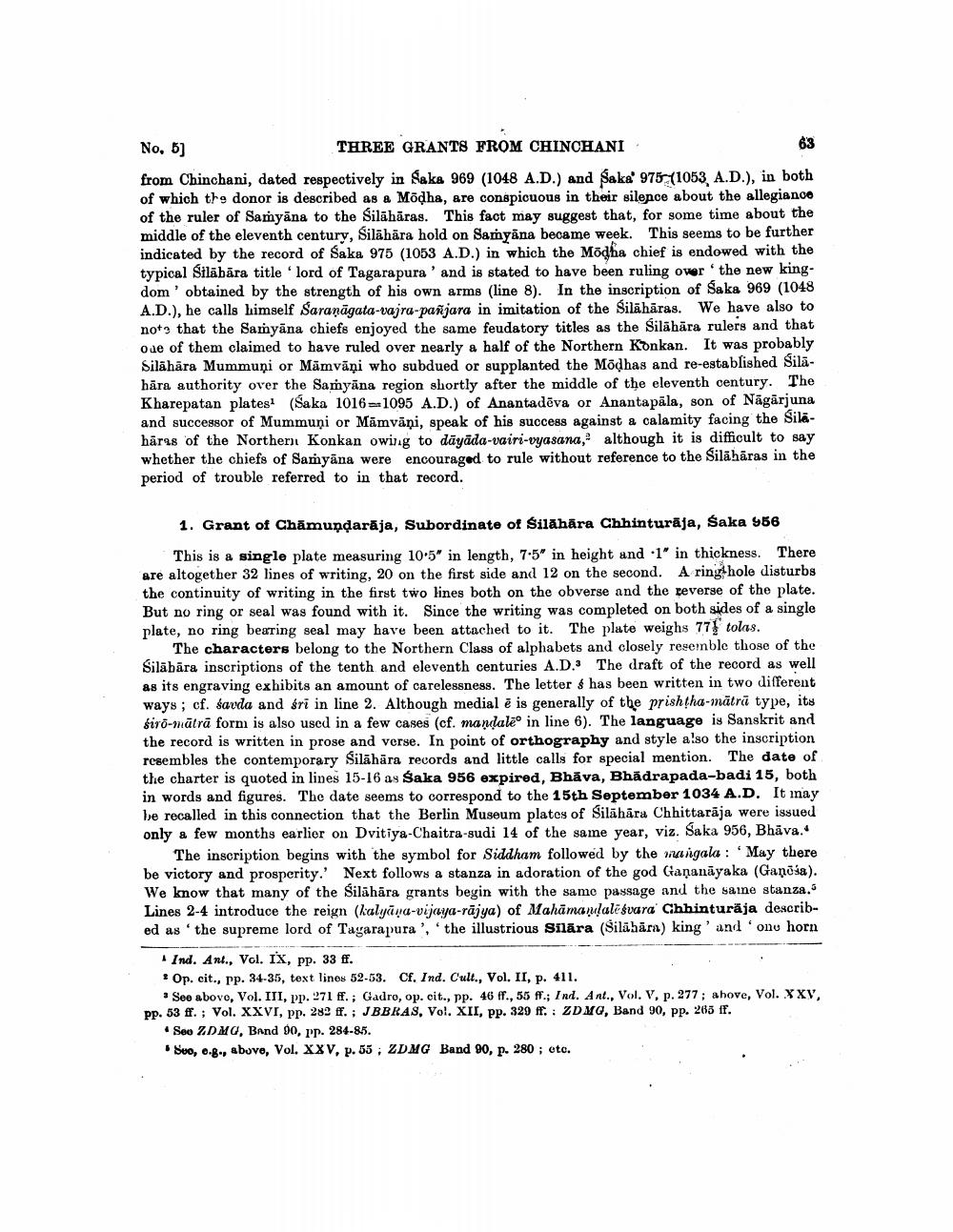________________
No, 5)
THREE GRANTS FROM CHINCHANI from Chinchani, dated respectively in Saka 969 (1048 A.D.) and Saka' 975:(1053 A.D.), in both of which the donor is described as a Mödha, are conspicuous in their silence about the allegiance of the ruler of Samyāna to the Silāhāras. This fact may suggest that, for some time about the middle of the eleventh century, Silāhāra hold on Samyana became week. This seems to be further indicated by the record of Saka 975 (1053 A.D.) in which the Mödha chief is endowed with the typical Silābāra title ' lord of Tagarapura' and is stated to have been ruling over the new kingdom' obtained by the strength of his own arms (line 8). In the inscription of Saka 969 (1048 A.D.), he calls himself Saranāgata-vajra-pañjara in imitation of the Silāhāras. We have also to note that the Samyāna chiefs enjoyed the same feudatory titles as the Silāhāra rulers and that one of them claimed to have ruled over nearly a half of the Northern Konkan. It was probably Silāhāra Mummuni or Māmvāņi who subdued or supplanted the Mòdhas and re-established Silahära authority over the Samyāna region shortly after the middle of the eleventh century. The Kharepatan plates (Saka 1016-1095 A.D.) of Anantadēva or Anantapāla, son of Nāgārjuna and successor of Mummuņi or Māmvāni, speak of his success against & calamity facing the Silahāres of the Northern Konkan owing to dāyāda-vairi-vyasana, although it is difficult to say whether the chiefs of Samyāna were encouraged to rule without reference to the Silahāras in the period of trouble referred to in that record.
1. Grant of Chāmundarāja, Subordinate of Silahāra Chhinturāja, Saka 456
This is a single plate measuring 10'5" in length, 7-5' in height and .1' in thickness. There are altogether 32 lines of writing, 20 on the first side and 12 on the second. A ring hole disturbs the continuity of writing in the first two lines both on the obverse and the reverse of the plate. But no ring or seal was found with it. Since the writing was completed on both sides of a single plate, no ring bearing seal may have been attached to it. The plate weighs 77 tolas.
The characters belong to the Northern Class of alphabets and closely resemble those of the Silābāra inscriptions of the tenth and eleventh centuries A.D.: The draft of the record as well as its engraving exhibits an amount of carelessness. The letter & has been written in two different ways; cf. savda and sri in line 2. Although medial é is generally of the prishtha-mātrā type, its siro-mātrā form is also used in a few cases (cf. mandale in line 6). The language is Sanskrit and the record is written in prose and verse. In point of orthography and style also the inscription resembles the contemporary Silähära records and little calls for special mention. The date of the charter is quoted in lines 15-16 as Saka 956 expired, Bhāva, Bhadrapada-badi 15, both in words and figures. The date seems to correspond to the 15th September 1034 A.D. It inay be recalled in this connection that the Berlin Museum plates of Silahāra Chhittarāja were issued only a few months earlier on Dvitiya-Chaitra-sudi 14 of the same year, viz. Saka 956, Bhāva.
The inscription begins with the symbol for Siddham followed by the waigala : May there be victory and prosperity. Next follows a stanza in adoration of the god Gananāyaka (Ganosa). We know that many of the Silāhāra grants begin with the same passage and the saine stanza." Lines 2-4 introduce the reign (kalyāna-vijaya-rajya) of Mahämanlalēgvara' Chhinturäja described as 'the supreme lord of Tagarapura', 'the illustrious Silāra (Silābāra) king' and 'onu horn
Ind. Ant., Vol. IX, pp. 33 ff. * Op. cit., pp. 34-35, text lines 52-53. Cf. Ind. Cult., Vol. II, p. 411.
* See abovo, Vol. III, pp. 271 ff.; Gadro, op. cit., pp. 46 ff., 55 ff.; Ind. Ant., Vol. V, p. 277 ; ahove, Vol. XXV, pp. 53 ff. ; Vol. XXVI, pp. 282 ff.; JBBRAS, Vol. XII, pp. 329 ff. : ZONG, Band 90, pp. 265 ff. . Seo ZDMO, Band 90, pp. 284-85.
Svo, 0.g., above, Vol. XXV, p. 55; ZDMG Band 90, p. 280 ; oto.




